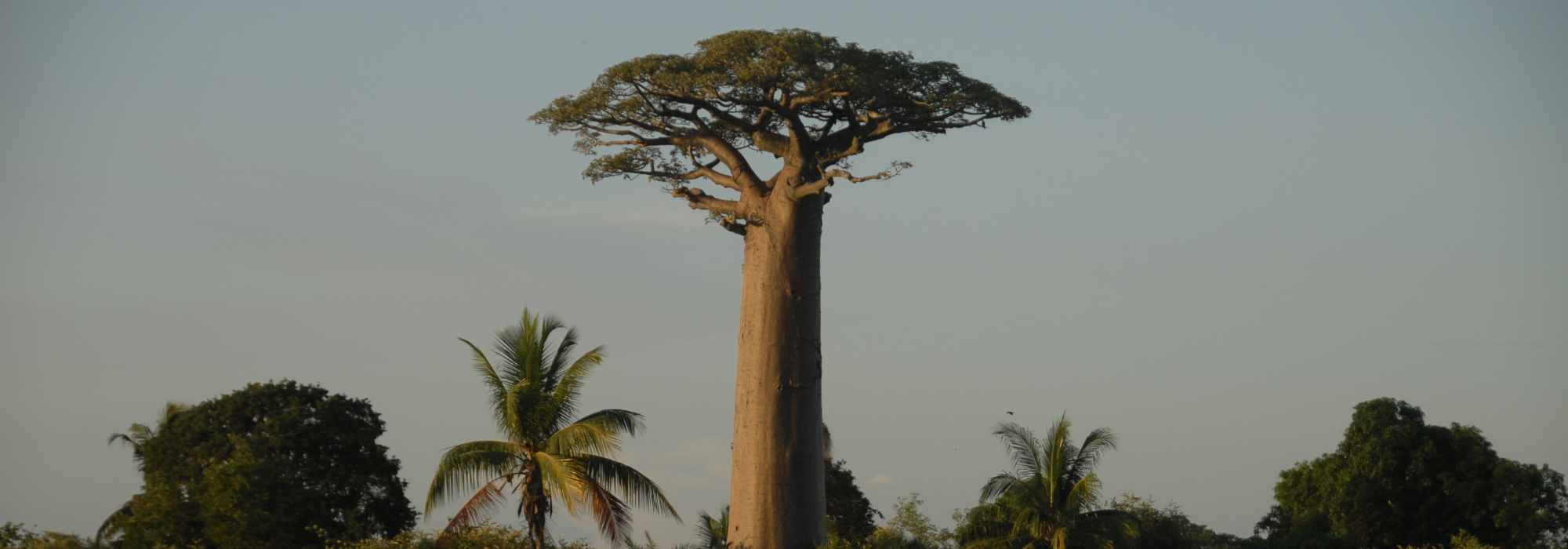
Adansonia - Baobab: Planting and Growing
Contents
The baobab tree in a few words
- Adansonia trees are primarily native to Africa, particularly Madagascar, where the greatest diversity of these majestic trees can be found.
- Some baobabs can live up to 6,000 years, making this genus one of the oldest and most resilient on Earth.
- The baobab is often referred to as the “tree of life” due to its many uses, including food, medicine, and even construction.
- Able to survive in arid conditions, Adansonia trees store significant amounts of water in their trunks, making them resilient to climate change.
- Despite their robustness, several species of baobabs are now endangered due to deforestation and climate change, requiring conservation efforts.
The word from our expert
When we talk about the botanical genus Adansonia, we’re actually referring to the true rock stars of the plant world. Baobabs are somewhat the Mick Jagger of the flora, with impressive longevity and a stage presence that leaves no one indifferent. Native mainly to Africa and Madagascar, these trees are the very symbol of resilience. They can store up to 120,000 litres of water in their trunk, a real reserve for lean days. A water tower on roots!
But that’s not all. Behind their wise old appearance, Adansonia hides more than meets the eye. Known by the nickname “tree of life,” they are at once a pharmacy, a grocery store, and a source of shade on hot days for the local population. From their leaves to their bark, and even their fruit, they have more than one trick up their sleeve to surprise you.
For us, they can only be grown in pots indoors or outdoors during the warmer season. But apart from that, it’s a hardy plant that will thrive even in our overheated and dry indoor environments.
So, the next time you come across a baobab on your travels (well, okay, you’d have to travel far…), don’t forget to salute this true patriarch of nature. It was here long before us and, if we make the necessary efforts in terms of conservation and combating climate change, it will be here long after us. And that’s rock’n’roll!
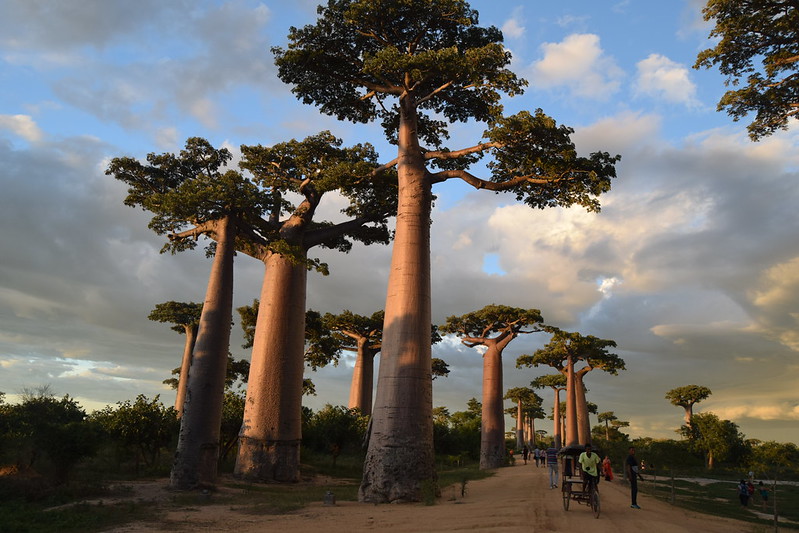
Botany and description
Botanical data
- Latin name Adansonia sp.
- Family Malvaceae
- Common name Baobab, Tree of life, Tree of tales
- Flowering from April to June depending on the species
- Height up to 25 m
- Exposure full sun
- Soil type dry and sandy, very well-drained
- Hardiness not hardy (10°C)
The botanical genus Adansonia, more commonly known as the baobab, comprises nine recognised species. Among the most well-known species are Adansonia digitata, the African baobab, and Adansonia grandidieri, the Madagascar baobab.
Regarding geographical distribution, six of the nine recorded species are endemic to the island of Madagascar. Only one species, Adansonia digitata, is native to the African continent and can also be found in the Middle East. Another, Adansonia gibbosa, is found in Australia. These trees primarily grow in arid and semi-arid environments and are well-adapted to harsh climates.
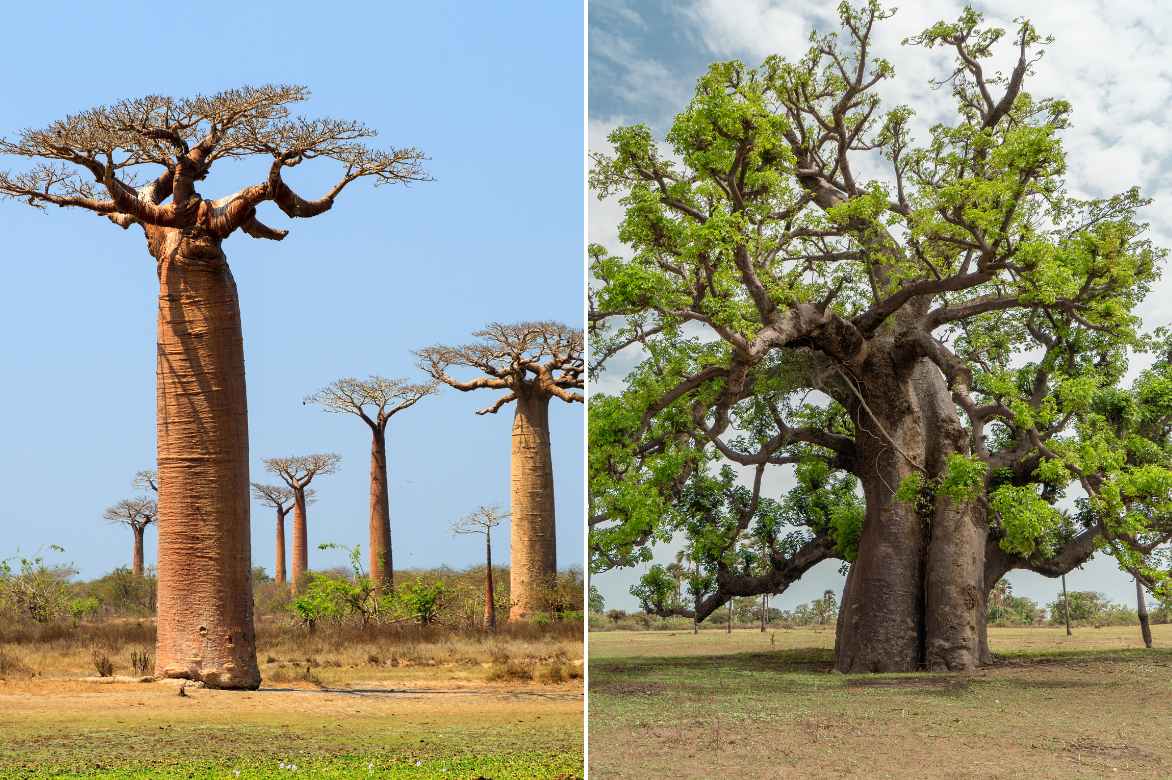
Adansonia grandidieri on the left and African baobab (A. digitata) on the right
From a phylogenetic classification perspective, Adansonia belongs to the Malvaceae family, which also includes plants like cotton and cacao, as well as linden trees, hibiscus, and lavateras. In the classical Cronquist classification, the Adansonia genus is placed in the Bombacaceae family.
Baobabs are fascinating trees not only for their impressive longevity, which can span several millennia, but also for their ability to store large quantities of water in their trunks. This makes them particularly resilient in environments where water resources are limited.
The habit of baobabs is often described as “upside-down,” meaning their branches resemble roots pointing skyward. This unique silhouette is one of the reasons these trees are so easily recognisable. The trunk is typically massive and cylindrical, capable of reaching impressive diameters. This voluminous trunk serves as a water reservoir, enabling the tree to survive in arid environments.
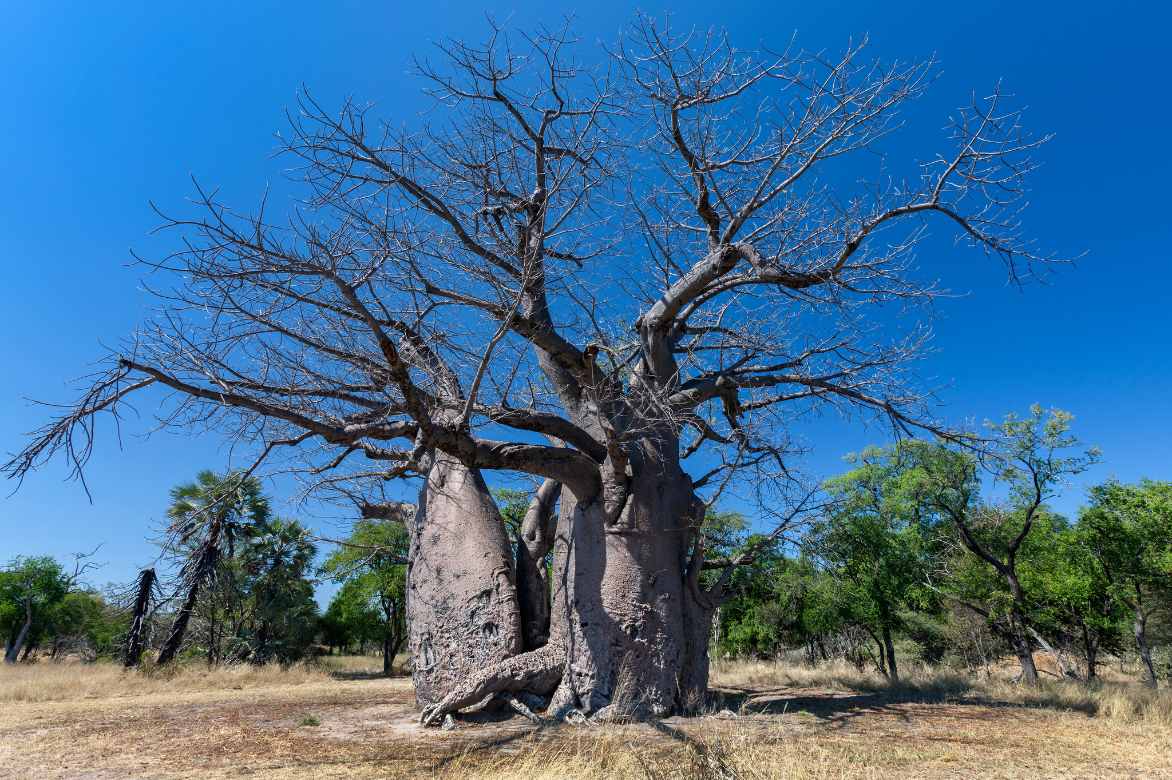
Baobab in the Botswana savannah: the trunk can become impressive…
The bark of Adansonia is smooth and grey, sometimes with reddish or brownish hues. It is also fibrous and elastic, allowing the tree to store even more water. The bark is frequently used in the production of ropes and textiles.
The leaves of baobabs are generally palmate, though their shape may vary depending on the species and environmental conditions. They are often deciduous, falling during the dry season to conserve water.
Regarding flowering, baobabs produce large, white flowers (except A. madagascariensis, which produces red flowers), typically pendulous. These flowers are primarily pollinated by bats and usually open at night. They have a very short lifespan, surviving only one night.
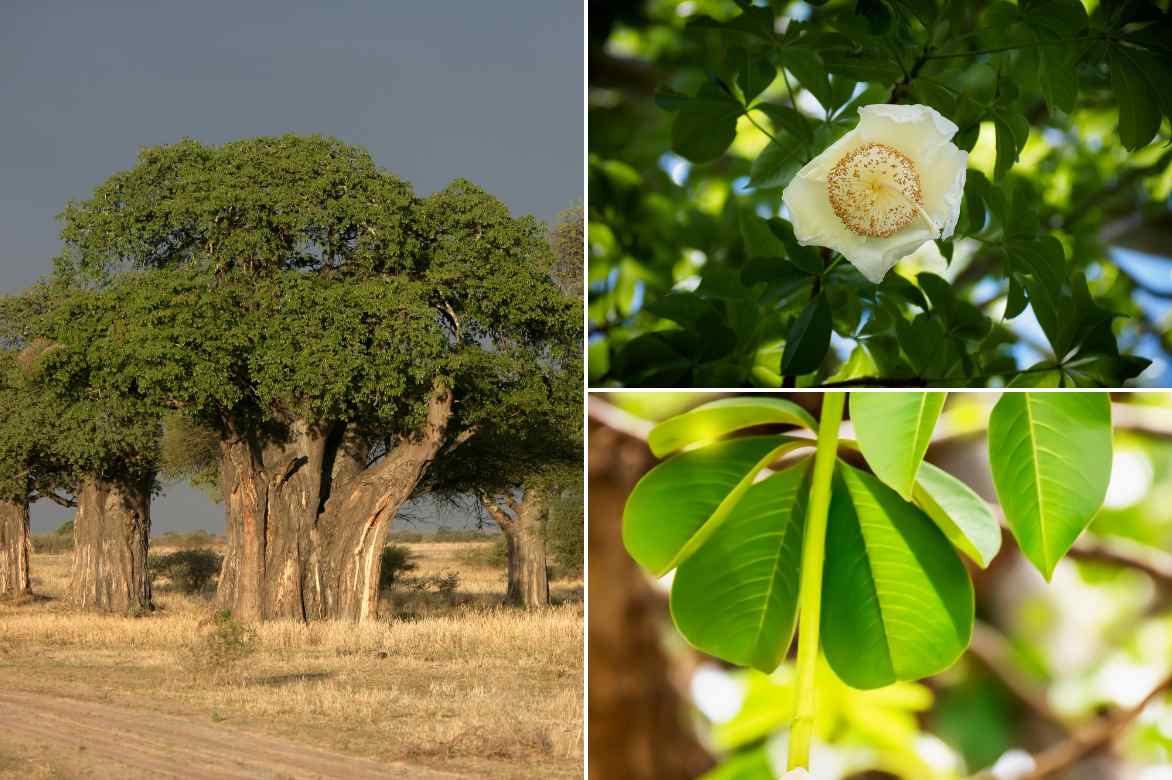
The tree, leafy during the rainy season. On the right, flower and foliage.
Fruiting follows flowering, producing elongated, oval fruits covered in a velvety shell. The fruits contain a dehydrated pulp rich in nutrients, used in dietary supplements and beverages.

Baobab fruits and seeds
The roots of baobabs are also adapted to survive in challenging environments. They can draw water from great depths, complementing their ability to store water in the trunk. Some species also develop shallow roots to quickly capture rainwater when available.
In terms of reproduction, some baobabs have developed strategies to increase their survival chances. For example, the seeds of certain species are very hard and require a process called scarification (mechanical or chemical treatment of the seed to improve germination) to enhance their germination rate.
Adansonia also plays an important ecological role in their natural habitat. They serve as sources of water and food for many animals and have even developed symbiotic relationships with certain species. For instance, birds like oxpeckers find refuge in their branches and, in return, help deter parasites.
It is also worth noting that different Adansonia species have specific adaptations to their environments. For example, Adansonia grandidieri from Madagascar has a thinner, more slender trunk compared to the Adansonia digitata of the African continent, an adaptation to the climatic and ecological differences of their respective habitats.
Given their longevity, some baobabs also hold significant cultural and spiritual importance for local communities. They are often regarded as “trees of tales,” where community meetings and ceremonies are held.
A few remarkable species
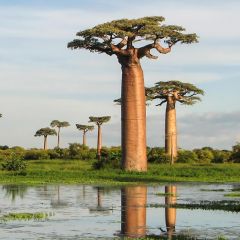
Adansonia grandidieri - Giant Baobab
- Flowering time April, May
- Height at maturity 25 m
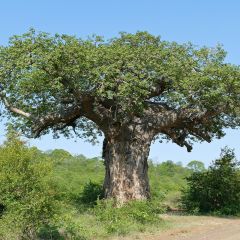
Adansonia digitata - Baobab
- Flowering time June, July
- Height at maturity 18 m
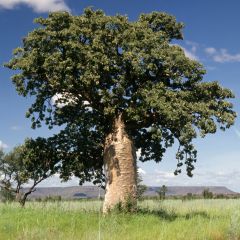
Adansonia gregorii - Boab
- Flowering time June, July
- Height at maturity 11 m
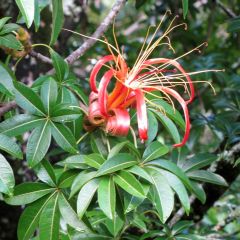
Adansonia madagascariensis - Madagascar baobab
- Flowering time May, June
- Height at maturity 20 m
Discover other Adansonia
View all →Available in 1 sizes
Available in 1 sizes
Available in 1 sizes
Available in 1 sizes
Available in 1 sizes
Available in 1 sizes
Available in 3 sizes
Available in 1 sizes
Planting an Adansonia
Where to Plant?
These majestic trees originate from dry tropical regions and are therefore well-suited to hot and arid climates.
In warm and dry areas of the world, planting in the ground can be attempted. It is important to choose well-drained soil to prevent water accumulation around the roots, which could lead to rot. Sandy soil is therefore ideal. Additionally, ensure the tree has plenty of space, not only for its aerial development but also for its root system, which can spread widely. Regarding exposure, baobabs prefer full sunlight. Avoid shaded or overly damp areas. It is also advisable to plant them in a spot sheltered from strong winds, as despite their robust appearance, they can be sensitive to extreme weather conditions.
Important! Planting an Adansonia in France or Belgium is obviously a real challenge, given that these tropical trees thrive in hot and dry climates. Therefore, they should be planted in pots and moved indoors when temperatures drop below 10°C. Ensure the container is large enough to accommodate the baobab’s root system and provide good drainage.
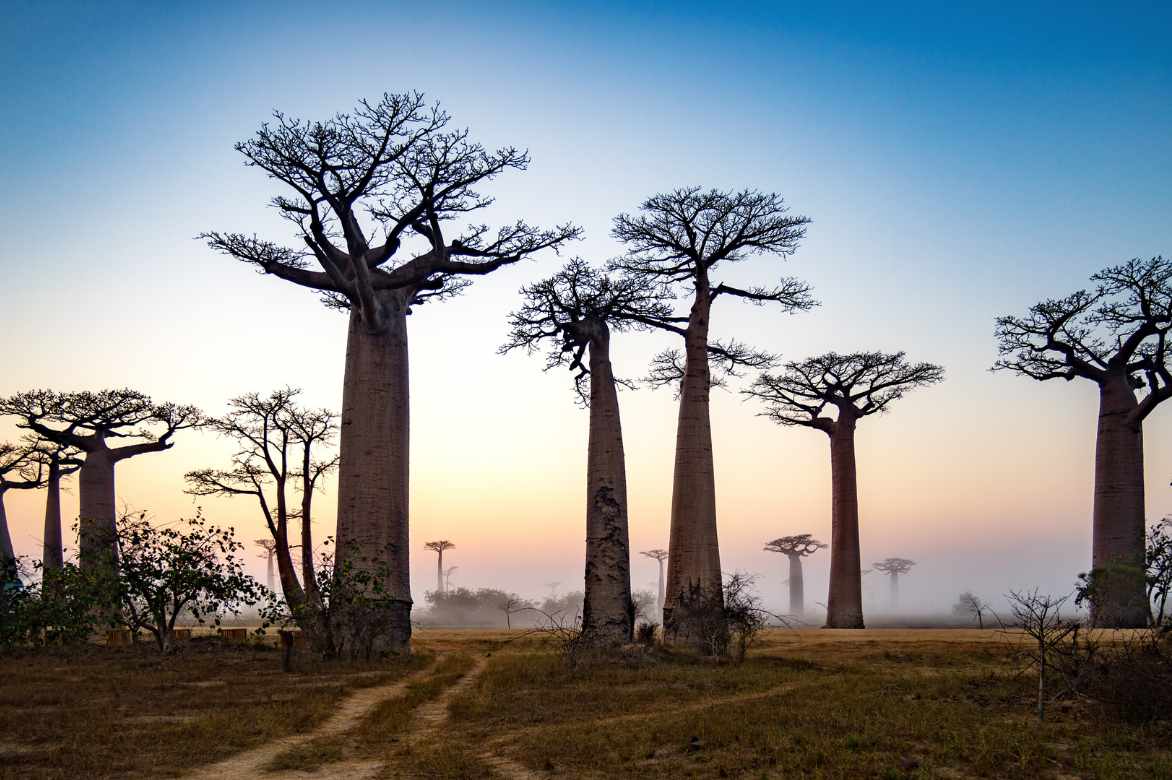
Baobabs, with their unique silhouette, in their natural environment
What Type of Pot to Choose?
It is recommended to start with a container at least 40 to 50 cm in diameter and depth. This will be sufficient to allow good root development without constraining them. After several years, you will need to repot your Adansonia into a larger container as the tree grows.
The material of the pot is also an important consideration. Terracotta pots are often recommended, as they allow better soil aeration and facilitate drainage, two key factors for the health of your baobab. Avoid plastic or metal pots, which do not breathe well and can retain too much moisture.
Finally, ensure the pot has sufficiently large drainage holes to prevent water accumulation at the bottom, which could lead to root rot. Good drainage is essential for this species, which prefers dry conditions.
When to Plant?
For growing an Adansonia indoors, you can plant it in a pot at any time of the year, provided you give it enough light and warmth. If your baobab has already been in a pot for several years and you simply want to repot it into a larger container, early spring is ideal for this task.
How to Plant a Baobab?
The choice of compost is a crucial element for successfully growing an Adansonia, or baobab, in a pot. This tropical species is native to arid regions and therefore prefers well-draining soil. A cactus or succulent compost mix can be a good starting point. These composts are typically composed of materials like sand, perlite, and organic compost, which ensure good drainage. You can also prepare your own mix by combining one part universal compost, one part coarse sand, and a small amount of perlite or vermiculite. This composition will prevent excessive water retention and facilitate root aeration.
- Place a layer of clay pebbles or gravel at the bottom of the pot to improve drainage.
- Partially fill the pot with your compost mix, then position your Adansonia, ensuring the root ball is level with the top edge of the pot. Fill the remaining gaps with the rest of the compost.
- Immediately after planting, water moderately to moisten the compost. Then, allow the soil to dry out between waterings to avoid any risk of root rot.
- Place your pot in a sunny spot, ideally sheltered from strong winds.
Pruning and Maintenance
Watering
The Adansonia is a plant that tolerates drought well. Water moderately and allow the soil to dry out between waterings. In winter, reduce the frequency of watering even further.
Pruning
Pruning is generally not necessary for potted Adansonia, unless you notice dead or diseased branches. In this case, use clean and well-sharpened pruning shears to make a clean cut.
Maintenance
Every two or three years, in spring, repot your Adansonia into a slightly larger container to encourage healthy growth. Use a well-draining soil mix, such as one for cacti or succulents.
Fertilisation
Use a balanced fertiliser, low in nitrogen (N ≤ 4), but rich in phosphorus and potassium, to be applied every two months during the active growth period. Fertilisers for cacti or succulents are often well-suited. Note that “bonsai” fertilisers can be an excellent solution due to their low nitrogen content.
Diseases and parasitic pests
Potted Adansonia are generally robust and less prone to diseases and parasitic issues. However, like any plant, they are not entirely immune to problems. Here are some of the most common health issues you may encounter.
Diseases
Root rot is often caused by overwatering and poor drainage, and it can be fatal if left untreated. The first sign is usually wilting leaves despite moist soil. First, remove the plant from the pot immediately to assess the extent of the damage. Trim away all rotten roots using sterilised garden scissors, ensuring only healthy roots remain. Then, repot the plant in a new pot with a good drainage system, using well-draining compost. After repotting, water the plant lightly to help the compost settle, but avoid overwatering, which could worsen the condition. During the recovery period, place the plant in a warm, well-lit spot, but avoid direct sunlight, which could cause further stress.
Powdery mildew is a fungal disease that appears as grey spots on the leaves. Prevention through good air circulation and moderate watering is the best solution.
Pests
Mealybugs attach themselves to the leaves and stems, sucking the sap from the plant. They can be removed with a cotton swab dipped in 90% alcohol.
Aphids are small green insects that feed on the plant’s sap and can cause general weakening. They are often naturally eliminated by predators when the plant is outdoors, but a strong jet of water or an insecticidal treatment may be necessary.
Poor Growing Conditions
Yellowed or discoloured leaves may indicate a nutrient deficiency. A balanced fertiliser can usually correct the issue.
Propagation of the Baobab
Sowing
The most commonly used method to propagate Adansonia is sowing. Collect mature seeds, ideally from a dried fruit. Soak them in warm water for about 24 hours to soften the shell and facilitate germination. Then, sow them in well-draining soil, at a depth of about 1 cm. Place the container in a warm and well-lit spot, and keep the soil slightly moist until germination, which can take anywhere from a few weeks to several months.
Propagation by Cuttings
Although this method is less common for Adansonia due to their slow growth, it is still possible. Take a stem cutting of about 10-15 cm in length, ideally during the plant’s active growth period. Allow the cutting to dry for a few hours to prevent rot, then plant it in a mixture of soil and sand. Maintain good humidity and place the cutting in a warm spot until it develops roots.
It should be noted that propagation by cuttings is riskier and less reliable than sowing, especially for slow-growing Adansonia varieties. Sowing remains the most recommended method.
How to pair a baobab tree?
Looking to create a little exotic corner to brighten up your home? You could opt for a baobab, such as a beautiful Adansonia madagascariensis with red flowers.
For a harmonious look, you might consider pairing it with other plants native to arid or semi-arid climates. Cacti and succulents, like a Madagascar aloe ‘Twirl’ or an echeveria ‘Elegance Rose’, can be excellent companions for your Adansonia. They share similar needs for water and light, making it easier to care for your potted garden. Along the same lines, you could choose a small mangave with dark grey foliage, ‘Lavender Lady’, and, a plant native to Madagascar, this fascinating fuzzy kalanchoe: Kalanchoe tomentosa.
Don’t forget to consider the potential size of your baobab and its companion plants, especially if you’re growing them indoors. Make sure there’s enough space for all the plants to grow without crowding each other.
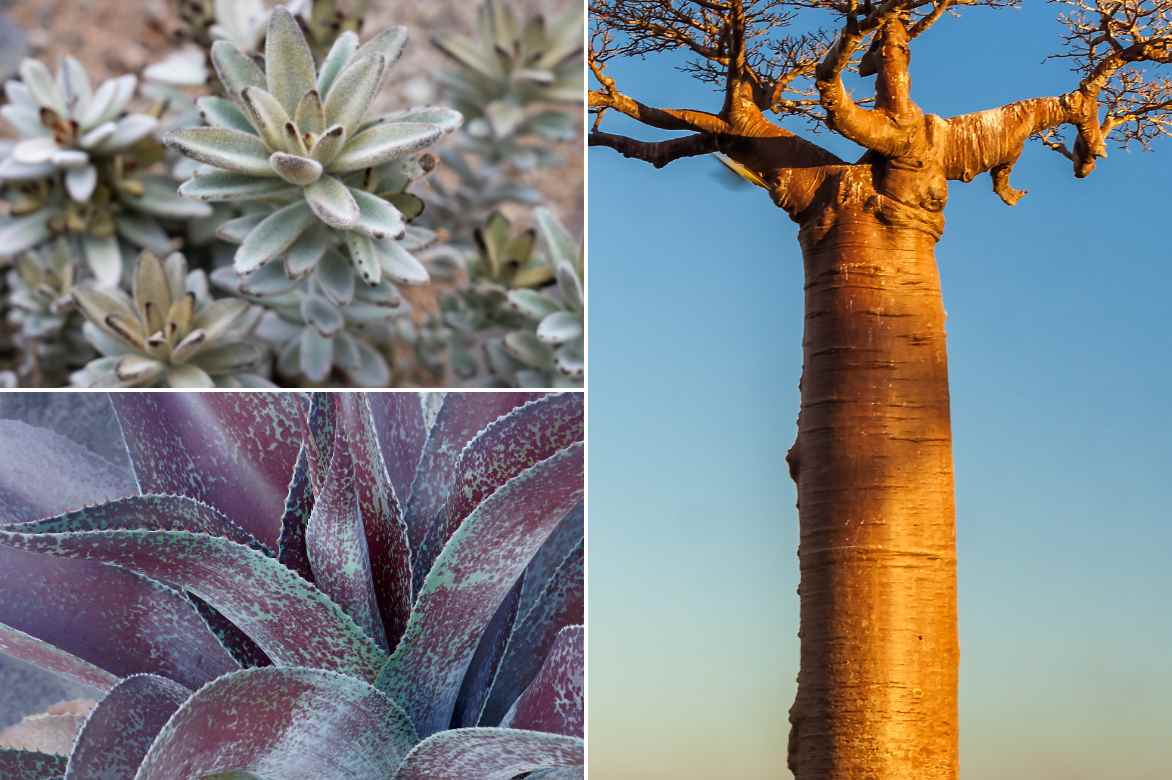
Kalanchoe tomentosa and mangave will make great companions for a potted baobab
Anecdotes
- The baobab is often nicknamed the “upside-down tree” because its branches resemble roots pointing towards the sky. This unique feature has given rise to various legends, including one that claims the baobab was planted upside down by the gods.
- An adult baobab can store up to 120,000 litres of water in its trunk! This reserve allows it to survive during droughts and is sometimes used as a water source by local communities.
- Almost every part of the baobab is usable. The leaves are eaten as a vegetable, the fruits are rich in vitamin C, and the bark is used to make ropes, baskets, and even clothing.
- Baobabs are among the oldest living organisms on the planet. Some specimens are estimated to be over 6,000 years old!
- Baobabs often represent an ecosystem in their own right, providing a habitat for a variety of birds, mammals (including bats that ensure their pollination), and insects. In some cultures, they are even considered “trees of discussion,” where the community gathers to talk and make decisions.
Useful resources
Discover our selection of Adansonia-Baobab in our online nursery.
Despite its astonishing resilience, the baobab is endangered in its natural medium due to deforestation and climate changes, among other factors. If you’d like to learn more, here are some articles on the subject:
Frequently asked questions
-
Can Adansonia be grown indoors?
Yes, Adansonia can indeed be grown indoors, especially when the outdoor climate conditions are not ideal for their growth. Baobabs require plenty of light to thrive, meaning at least 6 to 8 hours of direct sunlight each day. Unlike many indoor plants, Adansonia do not like constantly moist soil and need periods of dryness between waterings. Allow the compost to dry out completely before watering again.
-
Are baobabs frost-resistant?
No, baobabs (*Adansonia*) are not frost-resistant. Native to tropical and subtropical regions of Africa, Madagascar, and Australia, these majestic trees are not adapted to cold and frosty winter conditions. Exposure to frost can cause irreversible damage to the plant, ranging from leaf loss to root and trunk rot.
-
What is the average lifespan of an Adansonia in a pot?
The lifespan of an Adansonia or baobab in a pot can vary considerably depending on care conditions and the environment. In their natural habitat, these trees can live for several thousand years. However, in pots and under indoor conditions, their longevity is generally reduced. With proper care, a potted Adansonia can live for several decades.
-
How can I tell if my Adansonia needs watering?
The best indicator to know if your Adansonia needs water is the condition of the compost. Insert your finger into the soil to a depth of about 2-3 cm. If the compost is dry at this depth, it's a good sign that the plant needs watering. Another method: gently lift the pot. If it feels lighter than usual, it's probably time to water.
-
Do baobabs lose their leaves in winter?
Yes, most species of Adansonia, or baobabs, are deciduous, meaning they shed their leaves during the dry season in their natural habitat or during winter when grown indoors or outdoors in more temperate climates. This phenomenon is an adaptation to challenging environmental conditions; by shedding their leaves, baobabs minimise water loss through transpiration.
-
Do Adansonia produce flowers or fruits in pots?
Yes, Adansonia, more commonly known as baobabs, can produce flowers and even fruit when grown in pots, though this is quite rare and requires optimal growth conditions. Flowering and fruiting are more common in older, well-established baobabs, even when cultivated in pots.
- Subscribe!
- Contents
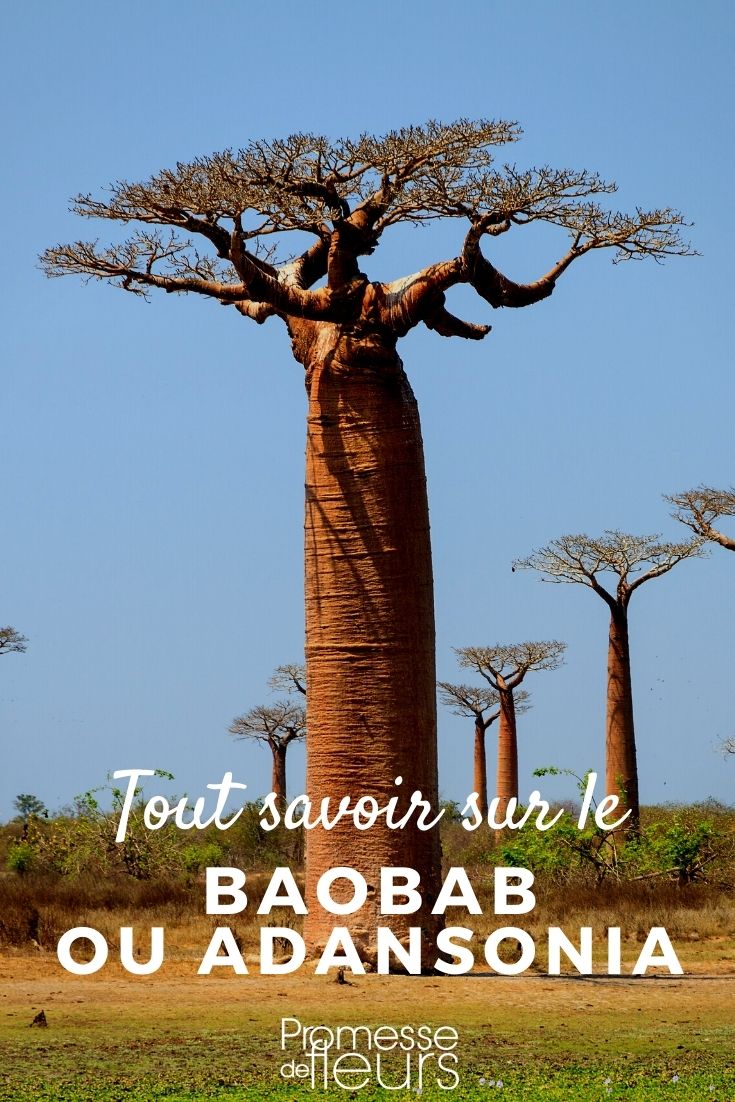


































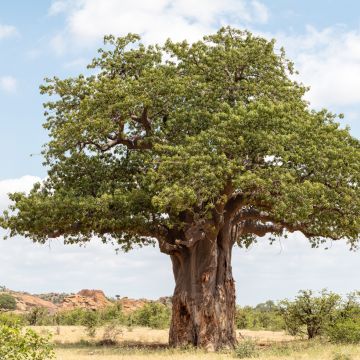
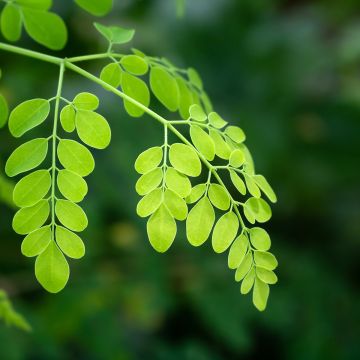
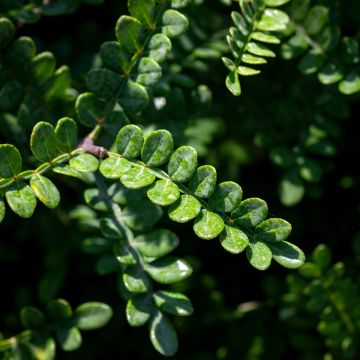
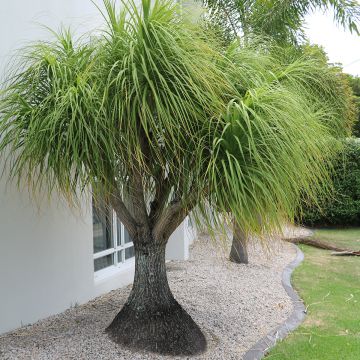

Comments